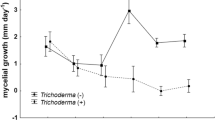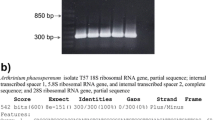Abstract
Verticillium biguttatum cannot utilise cellulose or nitrate-nitrogen and it requires biotin for growth, yet it grew and sporulated abundantly onRhizoctonia solani on cellulose, obtaining at least organic carbon, nitrogen and biotin fromR. solani. Videomicroscopy of inter-hyphal interactions on films of water agar showed thatV. biguttatum behaved as a biotrophic mycoparasite. From germinating spores, it penetrated the hyphae ofR. solani and formed haustorium-like branches without killing the host cells, and the haustoria supported an external mycelial network of the mycoparasite. Later the mycoparasite sporulated, and the infected host cells died. On cellulosic substrataV. biguttatum did not reduce the growth ofR. solani, and often enhanced the rate of cellulose degradation. However,V. biguttatum drastically reduced the production of sclerotia byR. solani, often completely suppressing sclerotium production when the mycoparasite infected only a localized region of the host colony. This is ascribed to the creation of a nutrient sink by the parasite, consistent with biotrophy. On plates of cellulose agar the suppression of sclerotia was not confined to parasitized colonies but extended to adjacent colonies ofR. solani that had successfully anastomosed with the parasitized colony. There was no effect on adjacent vegetatively incompatible colonies, where attempted anastomoses caused cytoplasmic death. In comparable experiments the necrotrophic mycoparasiteGliocladium roseum had no long-distance effect on sclerotium production byR. solani.
Suppression of sclerotium production may explain the reported success ofV. biguttatum in biocontrol of black scurf of potato in experimental field conditions.
Similar content being viewed by others
References
Adams PB (1990) The potential of mycoparasites for biological control of plant diseases. Annual Review of Phytopathology 28: 59–72
Adams PB and Ayers WA (1983) Histological and physiological aspects of infection of sclerotia ofSclerotinia spp. by two mycoparasites. Phytopathology 73: 1072–1076
Barnett HL and Binder FL (1973) The fungal host-parasite relationship. Annual Review of Phytopathology 11: 273–292
Berry LA, Jones EE and Deacon JW (1993) Interaction of the mycoparasitePythium oligandrum with otherPythium species. Biocontrol Science and Technology 3: 247–260
Boogert PHJF van den (1989a) Colonization of roots and stolons of potato by the mycoparasitic fungusVerticillium biguttatum. Soil Biology and Biochemistry 21: 255–262
Boogert PHJF van den (1989b) Nutritional requirements of the mycoparasitic fungusVerticillium biguttatum. Netherlands Journal of Plant Pathology 95: 149–156
Boogert PHJF and Velvis H (1992) Population dynamics of the mycoparasiteVerticillium biguttatum and its hostRhizoctonia solani. Soil Biology and Biochemistry 24: 157–164
Boogert PHJF van den, Jager G and Velvis H (1990)Verticillium biguttatum, an important mycoparasite for the control ofRhizoctonia solani in potato, pp 77–91 in Hornby D (ed) Biological Control of Soil-borne Plant Pathogens. CAB International, Wallingford
Boogert PHJF van den, Kastelein P and Luttikholt AJG (1994) Green crop harvesting, a mechanical haulm destruction method with potential for disease control of tuber pathogens in potato, pp 237–246 in Martin T (ed) Seed Treatment: Progress and Prospects. 1994 BCPC Monograph No. 57. British Crop Protection Council, Farnham
Boogert PHJF van den, Reinartz H, Sjollema KA and Veenhuis M (1989) Microscopic observations of the mycoparasiteVerticillium biguttatum withRhizoctonia solani and other soil-borne fungi. Antonie van Leeuwenhoek 56: 161–174.
Bullock S, Adams PB, Willetts MJ and Ayers WA (1986) Production of haustoria bySporidesmium sclerotivorum in sclerotia ofSclerotinia minor. Phytopathology 76: 101–103.
Chet I (1987)Trichoderma—application, mode of action, and potential as a biocontrol agent of soil-borne plant pathogenic fungi, pp 137–160 in Chet I (ed) Innovative Approaches to Plant Disease Control. Wiley, New York.
Christias C and Lockwood JL (1973) Conservation of mycelial constituents in four sclerotium-forming fungi in nutrient-deprived conditions. Phytopathology 63: 602–605.
Deacon JW (1976) Studies onPythium oligandrum, an aggressive parasite of other fungi. Transactions of the British Mycological Society 66: 383–391.
Deacon JW and Berry LA (1992) Modes of action of mycoparasites in relation to biocontrol of soilborne plant pathogens, pp 157–167 in Tjamos EC, Papavizas GC and Cook RJ (eds) Biological Control of Plant Diseases: Progress and Prospects for the Future, Plenum Press, New York.
Deacon JW and Henry CM (1978) Mycoparasitism byPythium oligandrum andP. acanthicum. Soil Biology and Biochemistry 10: 409–415.
Farrar JF and Lewis DH (1987) Nutrient relations in biotrophic infections, pp 92–132 in Pegg GF and Ayres PG (eds) Fungal Infection of Plants, Cambridge University Press, Cambridge.
Henis Y and Ben-Yephet Y (1970) Effect of propagule size ofRhizoctonia solani on saprophytic growth, infectivity, and virulence on bean seedlings. Phytopathology 60: 1351–1356.
Jager G, Velvis H, Lamers JG, Mulder A and Roosjen J (1991) Control ofRhizoctonia solani in potato by biological, chemical and integrated measures. Potato Research 34: 269–284.
Katan J, Ginzburg C and Freeman S (1992) The weakening effect as a trigger for biological control and criteria for its evaluation, pp 55–61 in Tjamos EC, Papavizas GC and Cook RJ (eds) Biological Control of Plant Diseases: Progress and Prospects for the Future, Plenum Press, New York.
Laing SAK and Deacon JW (1990) Aggressiveness and fungal host ranges of mycoparasiticPythium species. Soil Biology and Biochemistry 22: 905–911.
Laing SAK and Deacon JW (1991) Video microscopical comparison of mycoparasitism byPythium oligandrum, P. nunn and an unnamedPythium species. Mycological Research 95: 469–479.
Lewis JA, Papavizas GC and Lumsden RD (1991) Formulation system for the application of biocontrol fungi to soil. Biocontrol Science and Technology 1: 59–69.
Mandels M (1981) Cellulases. Annual Reports on Fermentation Processes 5: 35–78.
Martin FN and Hancock JG (1986) Association of biological and chemical factors in soil suppressive toPythium ultimum. Phytopathology 76: 1221–1231.
Mulligan DFC and Deacon JW (1992) Detection of presumptive mycoparasites in soil placed on host-precolonized agar plates. Mycological Research 96: 605–608.
Paulitz TC and Baker R (1988) Interactions betweenPythium nunn andPythium ultimum on bean leaves. Canadian Journal of Microbiology 34: 947–951.
Sundheim L (1986) Use of hyperparasites in biological control of biotrophic plant pathogens, pp 333–347 in Fokkema NJ and van den Heuvel J (eds) Microbiology of the Phyllosphere, Cambridge University Press, Cambridge.
Wessels JGH and Sietsma JH (1979) Wall structure and growth inSchizophyllum commune, pp 27–48 in Burnet JH and Trinci APJ (eds) Fungal Walls and Hyphal Growth, Cambridge University Press, Cambridge.
Author information
Authors and Affiliations
Rights and permissions
About this article
Cite this article
Van Den Boogert, P.H.J.F., Deacon, J.W. Biotrophic mycoparasitism byVerticillium biguttatum onRhizoctonia solani . Eur J Plant Pathol 100, 137–156 (1994). https://doi.org/10.1007/BF01876247
Accepted:
Issue Date:
DOI: https://doi.org/10.1007/BF01876247




